Playing Around With Stems
/7 Comments/in Design, Fruit, Gardening/by Lee ReichTop Doggery
Within any plant a push and pull goes on between fruiting an stem growth. Both require energy, which the plant has to apportion between the two. The more vigorously growing a stem, the less fruitful it is.
All this talk of hormones and inherent stem vigor is more than academic; it can translate into delicious fruits.
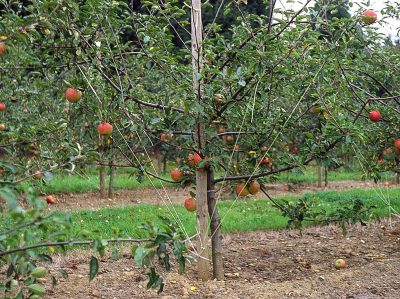
Tied branches in British orchard
But pear trees, especially in the youth, tend to put too much of their energies, too much for me, at least, into stem growth. The result is that they can take long time to settle down and begin bearing fruit.
Hence, the strings. I can change my pear trees’ habits by merely tying down branches, reducing the effect of that auxin so that growth is more uniform along a length of the stem. And, as important, slowing growth nudges the energy balance in the direction of fruiting.
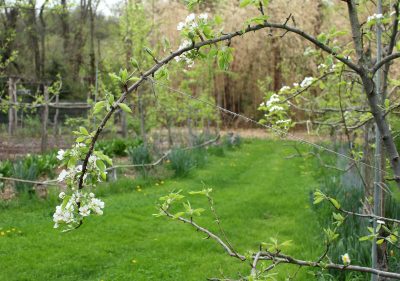
More Fruit or More Growth?
Branch bending is not only for coaxing a tree into fruiting. On young branches, it creates a wide angle between a branch and the developing trunk. Wide angles here have been shown to result in good anchorage, sturdy side branches that can carry a weight of fruit.
Suppressing the vigor of side branches also ensures that they won’t compete with the developing trunk, which needs to be top dog.
And using string to play around with plant hormones isn’t needed on every fruit tree. At the other extreme from pear in its growth and fruiting habits is peach. Peach is naturally very fecund, and becomes naturally so at a very young age.
Beauty, Fruit, and Fun
All this concern with auxin, vigor, and fruiting comes most prominently into play with espalier, which is the training of a tree to an orderly, often two dimensional form. The tracery of the branches themselves adds to the decorative value of the plant.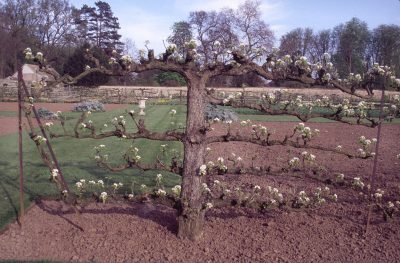
Fruiting espaliers, besides being decorative, produce very high quality fruit. Pruning and branch bending maintain a careful balance between yield and stem growth, and the form of the plant allows leaves and fruits to bathe in sunlight and air.

Bedding Down
/6 Comments/in Design, Planning, Vegetables/by Lee ReichFlat Beds
My vegetable garden is in beds. Your vegetable garden is in beds. Seems like just about everybody plants in beds these days. And with good reason. Beds make more efficient use of garden space. Soil compaction is avoided because planting, weeding, pruning, and harvesting can be done with feet in the paths. And the shapes of the beds can help make even a vegetable garden look prettier, especially with decorative plants edging the beds.
Raised beds are also one way to grow happy plants in otherwise poorly drained ground, or in ground that has been contaminated by lead or arsenic. Such contamination is likely to occur from past use of leaded gasoline near roadways, from old paint near buildings, and from residual pesticides in sites that were once orchards.
My vegetable garden is laid out in 3-foot-wide beds with 18-inch-wide paths between them that feed into one 5-foot-wide path down the center of the garden. Many gardeners, when considering planting in beds, equate that with RAISED beds. My vegetable beds are not intended to be raised even a hair above the paths.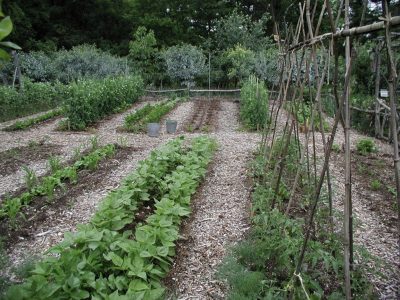
When I began my garden, I laid out the beds and covered them with compost, and then laid wood chips from local arborists in the paths. The difference in appearance of the two materials makes it easy to see where to walk and where not to walk. (For most people, that is. A well-known food writer once visited my garden. As I walked up a path, he tromped along next to me — right up the middle of the bed adjacent to the path! — until I let out a scream that brought him to an abrupt stop. Some lush plants in the bed were admittedly flopping onto the path, obscuring the difference between walking and planting areas.)
Raised Beds
Soil in raised beds is usually held there with boards or other edging. That edging material might itself be decorative: lumber, bricks, roof tiles, or, in a “colonial” garden, logs.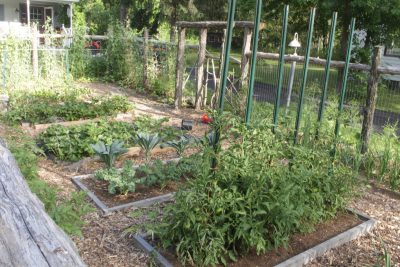
Ideally, any wooden edging is rot resistant. Locust or redwood would be my top choices, but hard to get. “Manufactured” lumber, such as Trex, is another possibility. Then again, pine or spruce boards are readily available, relatively inexpensive, and should last quite a few years.
A six-inch-high bed provides enough well-drained root depth for pretty much all vegetable plants.
One disadvantage to raised beds is that you have get soil to fill them up. That soil could, of course, come from what will be the paths. 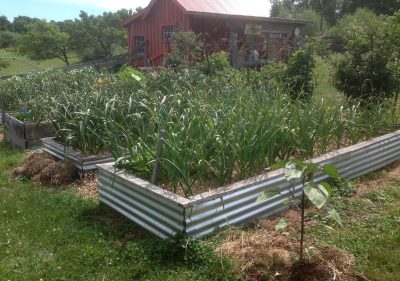 If the area is wet, though, taking soil from paths is going to lower them, making them that much wetter.
If the area is wet, though, taking soil from paths is going to lower them, making them that much wetter.
Most people bring in soil for raised beds, and, in the interest of having the best possible garden, make that “soil” compost. Not a good idea. For one thing, compost is mostly “organic matter,” meaning compounds of carbon, hydrogen, and oxygen. With time, as organic matter decomposes to nourish soil microorganisms and plants, it disappears, literally, becoming carbon dioxide and water. So a raised bed filled with compost will eventually shrink down to almost nothing.
The thing to do is to fill beds almost to their brims with any any well-drained soil. Fertility is not important; that will come from the one to two inches of compost with which the soil is topped. Replenishing the compost each year will provide all the nutrition plants need for that year; no additional fertilizer is necessary. And no need to dig or rototill the compost into the ground.
One more thing about raised beds: The improved drainage also means that they dry out faster, so benefit from irrigation.
Table-like Beds, Not
If you were to walk into my garden, you might notice that my planting beds are indeed a bit higher than the paths. This was not deliberate.
Each year for many years I’ve topped all my beds and an inch or two of compost. Paths get replenished with wood chips only if they start to get weedy or bare soil starts peeking through.
Paths get replenished with wood chips only if they start to get weedy or bare soil starts peeking through.
If it weren’t for decomposition, those yearly additions of compost would have made each bed into a “table” more than three feet high. It hasn’t. Q.E.D.
An Onion Relative and a Cabbage Relative
/7 Comments/in Gardening, Vegetables/by Lee Reich
Wild Leeks, Cultivated
I got pretty excited seeing rows of scrappy, green leaves emerging from the ground between a couple of my pawpaw trees. The leaves were those of ramps (Allium tricoccum, also commonly known as wild leeks) that I had first planted there two years ago, with an additional planting last year.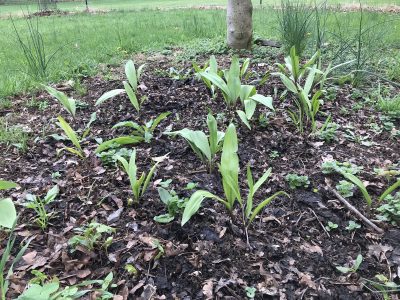
There’s no reason that ramps shouldn’t thrive here on the farmden; they’re native from Canada down to North Carolina and from the east coast as far west as Missouri. They’ve been best known in the southern Appalachian region, where festivals have long been held to celebrate the harvest.
Ramps became more widely known in the 1990s when, with the publication of a ramp recipe in Martha Stewart Living Magazine, the wilding became a foodie-food. Ramps are now threatened with being over harvested. Which, along with a desire to have this fresh-picked delicacy near the kitchen door, is the reason I planted them.
Large patches of ground in a forest preserve in New Jersey near to where a friend lives are blanketed each April with ramp greenery. We had dug up a few — very few — of the ramps, leaves and bulbs, which I transplanted here. Our harvest was not a threat to the ramp population. No one else has ever been seen harvesting there, and we dug up less than 1% of what was there. Research has shown that harvests are sustainable if no more than a different 5-10% of a planting are harvested yearly.
In the wild, ramps thrive in damp soil rich in organic matter in the shade of deciduous trees. My pawpaws provide the deciduous shade. The ground beneath those trees has been enriched each year for 20 years with a thick mulch of autumn leaves. To give the ground a further boost as far as organic matter and nutrients, I lay down a couple of inch thick blanket of compost over the bed last summer.
Over time, the bulbs should multiply and the plants further spread by self-seeding. I plan to harvest some seeds when they ripen in late summer to grow the seedlings under more controlled conditions.
The seeds have a double dormancy so they often don’t sprout until the second spring after ripening. The root dormancy, the result of immature embryos, is overcome with warmth and moisture. A warm autumn might be sufficient; if not, the next growing season. I plan to hurry the process along by potting up the seeds and keeping them warm (about 70°F) and moist for a couple of months. Then I’ll whisk the pot into the refrigerator to overcome the shoot dormancy, which requires a couple of months of cool, moist conditions, to jolt them awake. (More about natural blocks to seed germination in my new book The Ever Curious Gardener: Using a Little Natural Science for a Lot Better Garden.) The seedlings, as might be expected given their natural habitat, grow best with some shade — 30% shade to be exact, according to research.
Ramps are among the few perennial vegetables I grow. They are spring ephemerals, so in just a few weeks, their leaves will dissolve into the ground as the plants go dormant, to return again each spring for my dining pleasure.
A Different “Kale”
Seakale (Crambe maritima) is yet another perennial vegetable that I grow. It’s a cabbage relative that just now is sending up sprouts from its thickened roots. As soon as I noticed the sprouts, I covered the plants with an overturned, clay flowerpot, covering the drainage hole with a saucer to prevent light from reaching the plant.
Seakale tastes best blanched, that is, with its shoots grown in darkness. Under such conditions, leaves stretch out and grow pale and tender. In light, the taste of the leaves is too sharp. Or so I’ve read: Although I’ve grown seakale for many years, I wanted the roots to build up enough energy reserves to fuel new growth in the dark. This year, I will taste seakale.
Seakale will continue to earn a place in my garden even if its flavor falls flat (or sharp) because it’s a beautiful plant. Once released from the dark, new leaves emerge silvery green, large, and wavy. And then, later on in summer, foaming sprays of small white flowers emerge from within the whorl of leaves.
Expect a report on my take of seakale flavor in a couple of weeks, which is the time required for blanching. Like other perennial vegetables, once the harvest period ends, plants need to grow unfettered for the rest of summer to replenish the stored energy they spent fueling spring growth.

